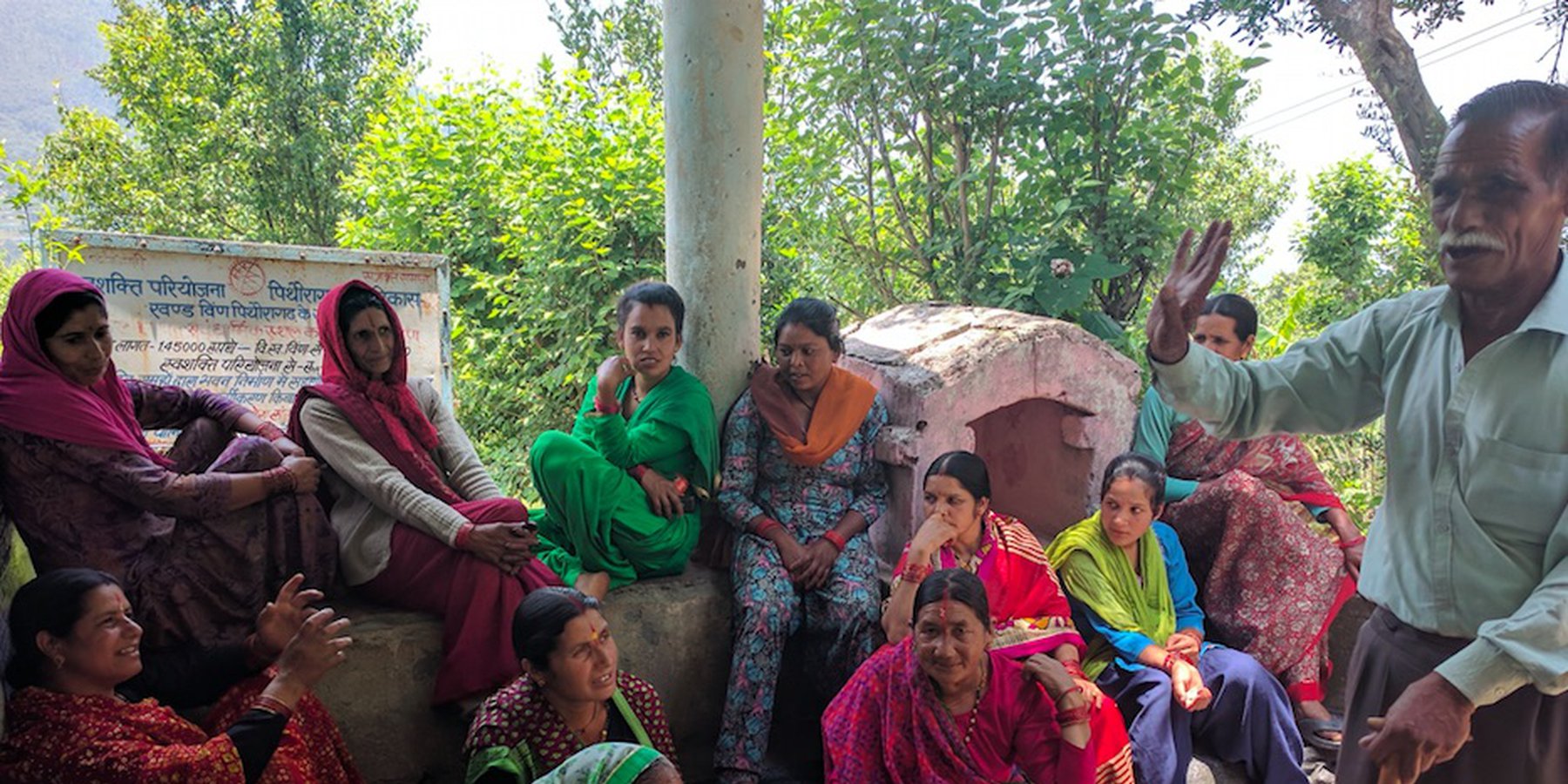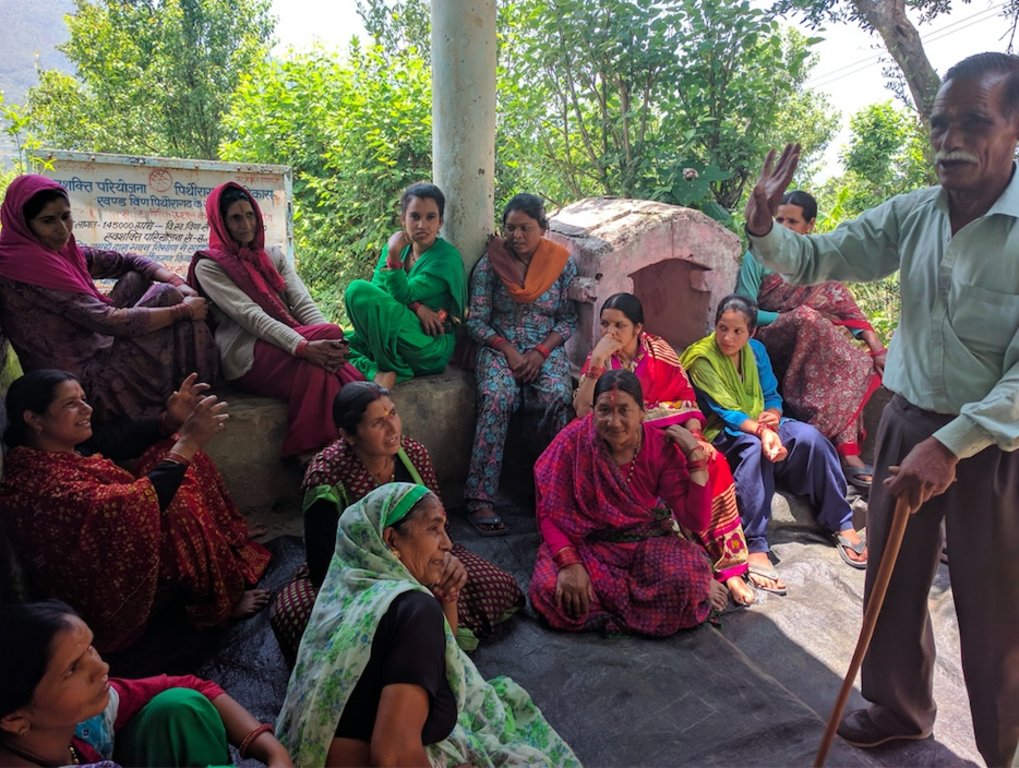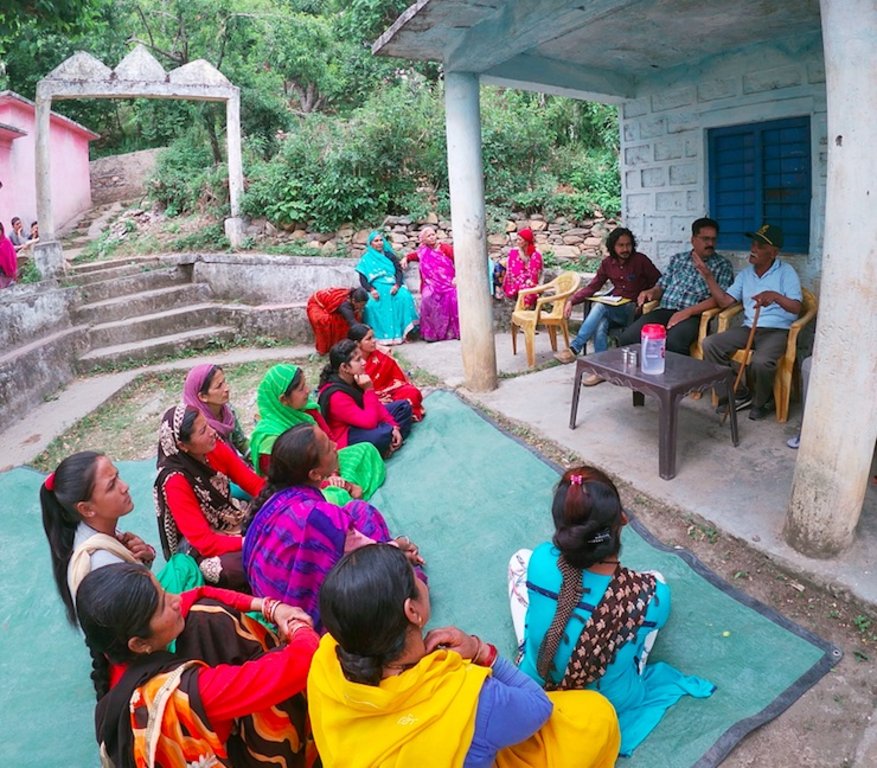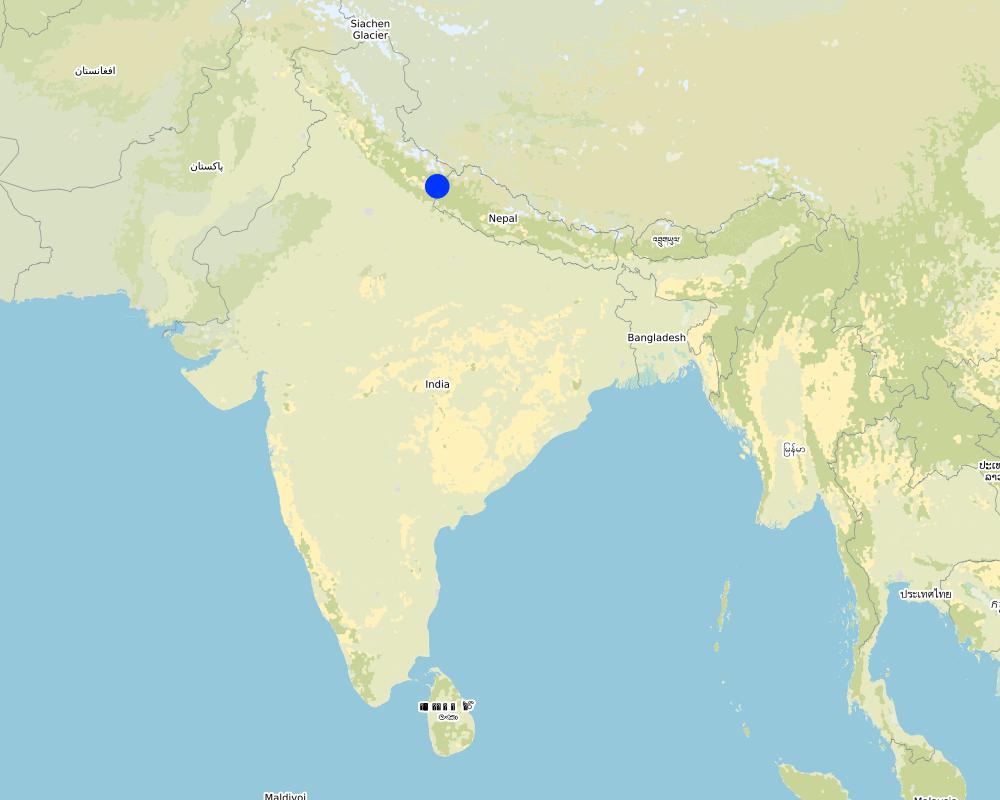Community Forest Management in the Nakina Van Panchayat [ប្រទេសឥណ្ឌា]
- ការបង្កើត៖
- បច្ចុប្បន្នភាព
- អ្នកចងក្រង៖ Jaclyn Bandy
- អ្នកកែសម្រួល៖ –
- អ្នកត្រួតពិនិត្យ Hanspeter Liniger
Van Panchayat
approaches_5199 - ប្រទេសឥណ្ឌា
- សង្ខេបជា PDF
- សេចក្តីសង្ខេបពេញលេញជាទម្រង់ PDF សម្រាប់បោះពុម្ព
- សេចក្តីសង្ខេបពេញលេញទម្រង់អ៊ីនធឺនេត
- សេចក្តីសង្ខេបពេញលេញ (មិនមានទម្រង់ជាក់លាក់)
- Community Forest Management in the Nakina Van Panchayat: 21 ខែ មេសា ឆ្នាំ 2020 (inactive)
- Community Forest Management in the Nakina Van Panchayat: 27 ខែ មិថុនា ឆ្នាំ 2021 (inactive)
- Community Forest Management in the Nakina Van Panchayat: 27 ខែ មិថុនា ឆ្នាំ 2021 (inactive)
- Community Forest Management in the Nakina Van Panchayat: 27 ខែ មិថុនា ឆ្នាំ 2021 (inactive)
- Community Forest Management in the Nakina Van Panchayat: 27 ខែ មិថុនា ឆ្នាំ 2021 (inactive)
- Community Forest Management in the Nakina Van Panchayat: 27 ខែ មិថុនា ឆ្នាំ 2021 (public)
ពិនិត្យមើលគ្រប់ផ្នែក
ពង្រីកមើលទាំងអស់ បង្រួមទាំងអស់1. ព័ត៌មានទូទៅ
1.2 ព័ត៌មានលម្អិតពីបុគ្គលសំខាន់ៗ និងស្ថាប័នដែលចូលរួមក្នុងការវាយតម្លៃ និងចងក្រងឯកសារនៃវិធីសាស្ត្រផ្សព្វផ្សាយ
បុគ្គលសំខាន់ម្នាក់ (ច្រើននាក់)
អ្នកប្រើប្រាស់ដី:
Jagdamda Joshi
+91 90120 10885
Sarpanch of Nakina Van Panchayat
Nakina Village, Pithoragarh Bloc, Uttarakhand, India
ប្រទេសឥណ្ឌា
ឈ្មោះគម្រោងដែលបានចងក្រងឯកសារ/ វាយតម្លៃលើវិធីសាស្ត្រផ្សព្វផ្សាយ (បើទាក់ទង)
Onsite and Offsite Benefits of SLMឈ្មោះអង្គភាពមួយ (ច្រើន) ដែលបានចងក្រងឯកសារ/ វាយតម្លៃលើវិធីសាស្ត្រផ្សព្វផ្សាយ (បើទាក់ទង)
ICIMOD International Centre for Integrated Mountain Development (ICIMOD) - ប្រទេសនេប៉ាល់ឈ្មោះអង្គភាពមួយ (ច្រើន) ដែលបានចងក្រងឯកសារ/ វាយតម្លៃលើវិធីសាស្ត្រផ្សព្វផ្សាយ (បើទាក់ទង)
G.B. Pant Institute of Himalayan Einvironment & Development (G.B. Pant Institute of Himalayan Einvironment & Development) - ប្រទេសឥណ្ឌា1.3 លក្ខខណ្ឌទាក់ទងទៅនឹងការប្រើប្រាស់ទិន្នន័យដែលបានចងក្រងតាមរយៈវ៉ូខេត
តើពេលណាដែលទិន្នន័យបានចងក្រង (នៅទីវាល)?
25/07/2019
អ្នកចងក្រង និង(បុគ្គលសំខាន់ៗ)យល់ព្រមទទួលយកនូវលក្ខខណ្ឌនានាទាក់ទងទៅនឹងការប្រើប្រាស់ទិន្នន័យដែលបានចងក្រងតាមរយៈ វ៉ូខេត:
បាទ/ចា៎
1.4 ការយោងមួយ (ច្រើន) ទៅលើ (កម្រង) បញ្ជីសំណួរនៃបច្ចេកទេស SLM
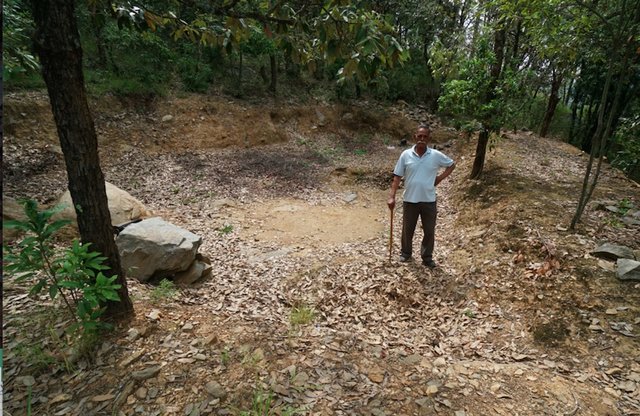
Recharge Ponds and Recharge Trenches [ប្រទេសឥណ្ឌា]
Recharge ponds (Chaals or khals) and recharge trenches (khanti) are common methods to catch the surface runoff and increase the infiltration to recharge groundwater and aid in natural spring recharge in the middle mountain regions.
- អ្នកចងក្រង៖ Jaclyn Bandy
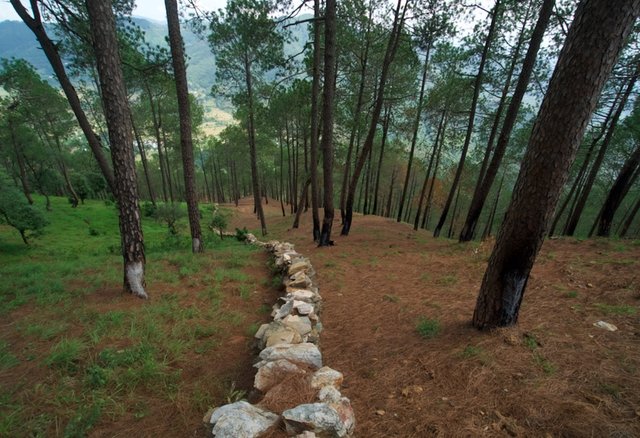
Stone Wall Fencing and Firebreak for Forest Protection [ប្រទេសឥណ្ឌា]
A rubble stone wall demarcates the community forest of Nakina Village and acts as a protective barrier against wildfire, wildlife, grazing, and human encroachment. The stone wall fencing is complemented by a firebreak, which is a gap of 2 meters. Firebreak establishment requires the removal of pine needles and debris …
- អ្នកចងក្រង៖ Jaclyn Bandy
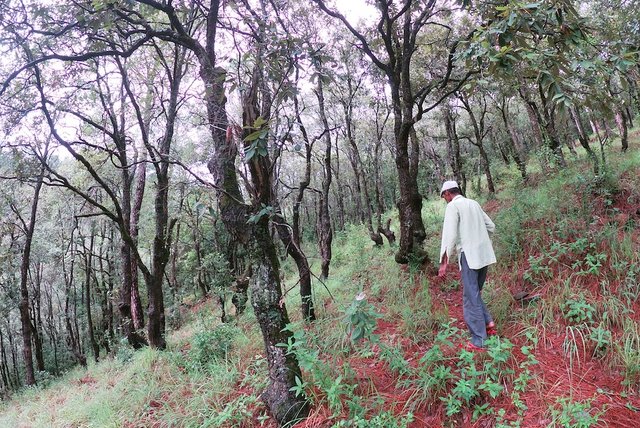
Broadleaf Plantations, Assisted Tree Regeneration and Fodder Nurseries … [ប្រទេសឥណ្ឌា]
Natural assisted regeneration of broadleaved species, a small oak plantation and a fodder nursery have been established in the Nakina community forest (intervention area: 10 ha), supporting fodder tree species such as Banj Oak and Falyaat, as well as various subtropical temperate fodder grass species. This has improved the livelihood …
- អ្នកចងក្រង៖ Jaclyn Bandy
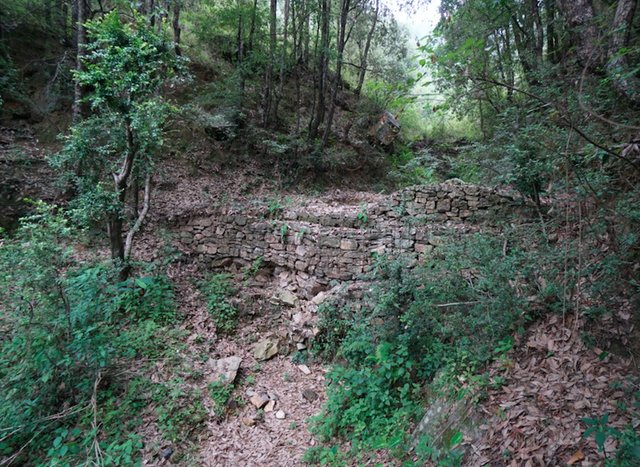
Stone Check Walls and Check Dams for Soil … [ប្រទេសឥណ្ឌា]
Stone Check Dams/Walls, Retainment Walls, and a Water Diversion Wall has been constructed in Nakina Village and Nakina Community Forest to help protect their settlements, agriculture land, forest land, and preserve the hilly landscape. These structures serve to reduce the runoff velocity (lowering the rate of erosion and gullying in …
- អ្នកចងក្រង៖ Jaclyn Bandy
2. ការពណ៌នាអំពីវិធីសាស្ត្រផ្សព្វផ្សាយ SLM
2.1 ពណ៌នាសង្ខេបខ្លីពីវិធីសាស្ត្រផ្សព្វផ្សាយ
Van Panchayats or village forest councils are a impressive example of grassroots community management of natural resources, where a specific administrative unit is locally elected by community members who are responsible for the management of activities related to the forest.
2.2 ពណ៌នាលម្អិតពិវិធីសាស្ត្រផ្សព្វផ្សាយ
ពណ៌នាលម្អិតពិវិធីសាស្ត្រផ្សព្វផ្សាយ:
Main Characteristics: the forest council has an odd number administrative committee (9), which allows a majority rule to resolve issues. From each household, one person will have the rights to elect the committee. The administrative committee makes the rules and regulations to manage and collect the fuel wood, fodder and wood to build houses or other structures. It also has the rights to collect the charges of using forest resources or penalize trespassers. The government and other institutions recognize this committee and communities for the protection of the forest, which also make joint plans and programs under the consultation with the forest user group and administrative committee. Van Panchayats are under the administrative control of the District Magistrate, though technical assistance is provided by the Forest Department. Organizations can provide financial and technical support to the administrative committee to implement projects.
Main objectives of this approach are:
•To mobilize the communities for sustainable natural resource management and distribute forest produce in an equitable manner
•To provide the financial and technical support for the communities to protect the forest's natural resources.
•To promote technologies for the conservation of natural resources and to increase the livelihood of people
•To encourage the people to establish tree plantations, fodder nurseries, biological and structural interventions for water conservation and maintain wildlife habitat
Methodology and Implementation:
To achieve the above mentioned objectives, the following methods were adopted: the first steps involved clarifying the status of forest utilization and local peoples' livelihood, activities and demands. Initially there was collaboration with the local people and forest department to demarcate the community forest and establish the Nakina van Panchayat in 1952 (according to the Forest Council Act 1931). Awareness-raising meetings informed the local people that the community forest health is determined by their own collective management. Over 30 years ago, Nakina Van Panchayat established a plantation area designated for the propagation of several broadleaved species. This has since been a growing enterprise, and encompasses an area of 7 hectares today. The Japan International Cooperation Agency (JICA) and Forest Department have assisted Nakina VP with this plantation. Despite these efforts there is still a gap in production. The community expressed this persistent availability gap of their fuelwood/fodder supply, and the necessity of maintaining the oak populations for groundwater recharge and spring rejuvenation.
Under the KSLCDI (Kailash Sacred Landscape Conservation and Development Initiative) and with support from ICIMOD, G.B. Pant Institute of Himalayan Environment and Sustainable Development and Nakina Van Panchayat created a plantation area supporting oak and other broadleaved species over an area of 2 hectares (2014-2016) . The community also established a small oak and fodder nursery with support from the Uttarakhand Forest Department, NGO Swati Gramodyog Sansthan (SGS) and NGO Himalayan Sewa Samiti (HSS).
Stakeholders involved and their role:
1. Broadleaf Plantation (+30 years ago, community initiated)
Japan International Cooperation Agency (JICA), UKFD (Uttarakhand Forest Department)- funding, technical and advisory support
Nakina Van Panchayat and Nakina Community: participatory action in all phases of approach, planting, on-going maintenance
2. Oak Plantation
ICIMOD- funding
G.B Pant: project implementation, on-site advisory and technical support
UKFD (Uttarakhand Forest Department)- technical and advisory support
Nakina Van Panchayat and Nakina Community: participatory action in all phases of approach, planting, on-going maintenance
3. Fodder and Oak Nursery
Fodder Nursery: NGOs SGS, HSS- project implementation, provision of plants, planting techniques, and financial assistance
Oak Nursery- self-initiative by Nakina Van Panchayat and the forest user group (local People)
UKFD: gave technical advice and provided financial support to Nakina Van Panchayat; distributed plants and grasses
G.B Pant: organized a 7-day capacity building training in Nakina Village and supported the plantation establishment; there are ongoing projects with Nakina to develop other parts of the forest
Comments on Approach: Land users are very pleased with the success of these approaches. However they stress the need to strengthen on-going communication between various stakeholders and supporting institutions for project optimization, as well as continual support and auditing post-project. More follow up with technical experts would be highly appreciated by the land users.
2.3 រូបភាពនៃវិធីសាស្ត្រផ្សព្វផ្សាយ
2.5 ប្រទេស/តំបន់/ទីតាំងកន្លែង ដែលវិធីសាស្ត្រផ្សព្វផ្សាយត្រូវបានអនុវត្តន៍
ប្រទេស:
ប្រទេសឥណ្ឌា
តំបន់/រដ្ឋ/ខេត្ត:
Uttarakhand
បញ្ជាក់បន្ថែមពីលក្ខណៈនៃទីតាំង:
Nakina Village, Pithoragarh Bloc
Map
×2.6 កាលបរិច្ឆេទនៃការចាប់ផ្តើម និងបញ្ចប់នៃវិធីសាស្រ្តផ្សព្វផ្សាយនេះ
សូមបញ្ជាក់ឆ្នាំដែលបានបង្កើតឡើង:
1952
មតិយោបល់:
The Nakina Van Panchayat was established in 1952 and has been under the leadership of Mr. Jagdamba Joshi for the past 5 years. The broadleaf plantation started +30 years ago. no The fodder nursery was established in 2011-2012. The oak plantation and nursery was established in 2014-2016.
2.7 ប្រភេទនៃវិធីសាស្ត្រផ្សព្វផ្សាយ
- The approach combines efforts between traditional systems/local initiatives/and projects funded by other organizations.
2.8 គោលបំណង/ទិសដៅសំខាន់នៃវិធីសាស្ត្រផ្សព្វផ្សាយ
Main objectives of this approach are:
•To protect and develop the forest under the jurisdiction of the Nakina Van Panchayat
•To mobilize the communities for sustainable natural resource management and distribute forest produce in an equitable manner
•To provide or seek out financial and technical support for the communities to protect the forest's natural resources.
•To promote technologies for the conservation of natural resources and to increase the livelihood of people
•To encourage the people to establish tree plantations (broadleaved species), fodder nurseries, biological and structural interventions for water/soil moisture conservation and maintain wildlife habitat.
•Deep-rooted species like oak facilitate better ground-water seepage and enhance spring discharge rates for the communities downstream
2.9 លក្ខខណ្ឌអនុញ្ញាត ឬរារាំងការអនុវត្តន៍បច្ចេកទេសដែលស្ថិតនៅក្រោមវិធីសាស្រ្តផ្សព្វផ្សាយ
សង្គម/វប្បធម៌/ និងតម្លៃនៃសាសនា
- អំណោយផល
ភាពអាចរកបាននៃធនធានហិរញ្ញវត្ថុ និងសេវាកម្ម
- អំណោយផល
Under the 1976 Van Panchayat Rules, the access and authority to control funds was greatly improved and the share of forest income was increased from 40% to 80%.
- រារាំង
A Forest Department official is placed inside each VP, controlling its activities as a joint account holder. VP proposals for using their income need prior approval from the Divisional Forest Officer, who may modify how the village institutions use their own income
បរិបទនៃស្ថាប័ន
- អំណោយផល
- រារាំង
ការសហការ/ការសម្របសម្រួលតួអង្គពាក់ព័ន្ធ
- អំណោយផល
In Uttarakhand, NGOs and civil society groups have historically played a strong advocacy role. The government (forest dept), NGOs, research institutions, and external organizations have been actively working together on various projects across Uttarakhand to support Van Panchayat Forest Joint Management (VFJM). For example, in 2015 total of 750 Van Panchayats in the state have been funded by the Japanese International Cooperation Agency (JICA), providing 85% of the financial support needed for forest restoration programs, as well as soil and water conservation.
- រារាំង
Today, the NGO movement is split into different camps and factions. The vast majority has been co-opted to work as "private service providers" for several donor-funded projects, including the forestry project. Once they accept working on project terms, they effectively lose their critical and questioning voice. Consequently, the potential damage to the region’s unique Van Panchayats from VFJM has been subdued by these changes.
ក្របខណ្ឌច្បាប់ (សិទ្ធិកាន់កាប់ដីធ្លី កម្មសិទ្ធីប្រើប្រាស់ដីនិងទឹក)
- អំណោយផល
គោលនយោបាយ
- អំណោយផល
Although there have been historical challenges around forest policies and resource use due to British colonialism, within the last 20 years or so there has been major change in Indian forest policies, Van Panchayat rules and people’s participation in forest management. In 2006, the Indian parliament passed the Forest Rights Act, which for the first time, fully recognized the rights of people over forests and other related natural resources and made these rights independent of the encroachment of forest department.
- រារាំង
Annual plans for VP forest management are actually written by Forest Department staff and subsequently implemented with the involvement of only the Sarpanch and/or some of the elected panchayat members. Villagers are provided only wage labour and are not actively engaged in the planning process.
អភិបាលកិច្ចដី (ការសម្រេចចិត្ត ការអនុវត្ត និងការរឹតបន្តឹង)
- អំណោយផល
The joint forest management approach (between local people and government) supports coordination with the people, ownership and access to the forest resources. Each VP can make its own rules and needs as per needs and wisdom.
- រារាំង
Still there are unrelenting difficulties between government support/response regarding forest management in the hill regions. While some governments and communities have governed forests sustainably, others struggle to mitigate degradation or lack commitment to manage forests sustainably, as there are vested powers in the Forest Dept that limit land-users opportunity to participate in the decision making process.
ចំណេះដឹងស្តីពី SLM និងការទទួលបានការគាំទ្រផ្នែកបច្ចេកទេស
- អំណោយផល
Technical support in the form of extensions services, trainings, and advisory support throughout project implementations are provided by various institutions.
- រារាំង
However the support is not consistent and on-site consultations with landusers is limited to the short-term projects
ទីផ្សារ (ទិញធាតុចូល លក់ផលិតផល) និងតម្លៃ
- អំណោយផល
Through this approach, the people are unique position and ability to develop alternative agriculture-based strategies (herbs, aromatic plantations). Uttarakhand has been declared as an Organic State and has recently received significant government funding to develop organic farming ( as of January 31, 2018 about Rs 1,500 crore for three years has been sanctioned.)
- រារាំង
At the present time, the status of agricultural market development needs a lot of work. The most crucial factor appears to be linking the producer with the local markets. Current production is mainly for self consumption. Agricultural yields are not very high in Uttarakhand as a whole and also the productivity of the hill districts is generally lower than the state average.
ទំហំការងារ ភាពអាចរកបាននៃកម្លាំងពលកម្ម
- អំណោយផល
Women are the effective managers of the rural household economy and forest resource use. They are active participants in the VP activities, either as official committee members or routine attendees of VP meetings
- រារាំង
Lack of employment has led to high male out-migration and lack of interest in forest management
3. ការចូលរួម និងតួនាទីរបស់ភាគីពាក់ព័ន្ធ
3.1 អ្នកពាក់ព័ន្ធដែលបានចូលរួមក្នុងវិធីសាស្ត្រផ្សព្វផ្សាយ និងតួនាទីរបស់ពួកគេ
- អ្នកប្រើប្រាស់ដីក្នុងតំបន់/សហគមន៍
Naikina Van Panchayat (9 members)
Naikina Village (300 people)
- អ្នកស្រាវជ្រាវ
G.B. Pant
- អង្គការក្រៅរដ្ឋាភិបាល
Himalayan Sewa Samiti
- រដ្ឋាភិបាលថ្នាក់មូលដ្ឋាន
District Magistrate
Uttarakhand Forest Department, Government of India
- អង្គការអន្តរជាតិ
ICIMOD
JICA (Japan International Cooperation Agency)
Financial Assistance
3.2 ការចូលរួមរបស់អ្នកប្រើប្រាស់ដីក្នុងតំបន់/ សហគមន៍ក្នុងតំបន់ក្នុងដំណាក់កាលផ្សេងគ្នានៃវិធីសាស្រ្តផ្សព្វផ្សាយ
| ការចូលរួមរបស់អ្នកប្រើប្រាស់ដីក្នុងតំបន់/សហគមន៍ក្នុងតំបន់ | សូមបញ្ជាក់នរណាត្រូវបានចូលរួម ព្រមទាំងពណ៌នាសកម្មភាពទាំងនោះ | |
|---|---|---|
| ការចាប់ផ្តើម/ការលើកទឹកចិត្ត | អន្តរកម្ម | |
| ការរៀបចំផែនការ | អន្តរកម្ម | |
| ការអនុវត្តន៍ | អន្តរកម្ម | |
| ការត្រួតពិនិត្យ និងវាយតម្លៃ | គំនិតផ្តួចផ្តើមដោយខ្ឡួនឯង | |
| maintenance | គំនិតផ្តួចផ្តើមដោយខ្ឡួនឯង |
3.4 ការសម្រេចចិត្តលើការជ្រើសរើសបច្ចេកទេស SLM
សូមបញ្ជាក់តើអ្នកណាជាអ្នកបានសម្រេចចិត្តក្នុងការជ្រើសរើសបច្ចេកទេសដើម្បីយកមកអនុវត្តន៍:
- គ្រប់ភាគីពាក់ព័ន្ធទាំងអស់ដែលជាផ្នែកនៃវិធីសាស្រ្តផ្សព្វផ្សាយដោយមានការចូលរួម
សូមបញ្ជាក់ តើការសម្រេចធ្វើឡើងដោយផ្អែកលើអ្វីជាមូលដ្ឋាន:
- វាយតម្លៃទៅលើចំណេះដឹងស្តីអំពី SLM ដែលបានចងក្រងជាឯកសារបានត្រឹមត្រូវ (ផ្អែកលើភស្តុតាងជាមូលដ្ឋានដើម្បីសម្រេចចិត្ត)
- បទពិសោធន៍ និងគំនិតផ្ទាល់ខ្លួន(ពុំមានចងក្រងជាឯកសារ)
4. ជំនួយបច្ចេកទេស ការកសាងសមត្ថភាព និងការគ្រប់គ្រងចំណេះដឹង
4.1 ការកសាងសមត្ថភាព/ បណ្តុះបណ្តាល
តើវគ្គបណ្តុះបណ្តាលបានផ្តល់ឱ្យអ្នកប្រើប្រាស់ដី/អ្នកពាក់ព័ន្ធផ្សេងៗទៀតដែរឬទេ?
បាទ/ចា៎
សូមបញ្ជាក់តើអ្នកណាត្រូវបានបណ្តុះបណ្តាល:
- អ្នកប្រើប្រាស់ដី
ទម្រង់នៃការបណ្តុះបណ្តាល:
- អនុវត្តន៍ជាមួយការងារ
- ការប្រជុំជាសាធារណៈ
ប្រធានបទបណ្តុះបណ្តាល:
Forest management, forest fire, plantation, spring restoration
4.2 សេវាផ្តល់ប្រឹក្សាយោបល់
តើអ្នកប្រើប្រាស់ដីបានទទួលនូវសេវាផ្តល់ប្រឹក្សាដែរ ឬទេ?
បាទ/ចា៎
សូមបញ្ជាក់ប្រសិនបើសេវាកម្មប្រឹក្សាយោបល់ត្រូវបានផ្តល់ឱ្យ:
- នៅលើដីរបស់អ្នកប្រើប្រាស់ដី
4.3 ការពង្រឹងសមត្ថភាពស្ថាប័ន (ការអភិរឌ្ឍន៍អង្គភាព)
តើស្ថាប័នទាំងអស់ត្រូវបានបង្កើតឡើង ឬពង្រឹងសមត្ថភាពតាមរយៈវិធីសាស្ត្រផ្សព្វផ្សាយដែរ ឬទេ?
- បាទ/ច៎ា ជាមធ្យម
សូមបញ្ជាក់ថាតើស្ថាប័នត្រូវបានពង្រឹង ឬបង្កើតឡើងនៅត្រឹមកម្រិតណា(ច្រើន)?
- ថ្នាក់មូលដ្ឋាន
សូមបញ្ជាក់ប្រភេទនៃការគាំទ្រ:
- ហិរញ្ញវត្ថុ
- ការកសាងសមត្ថភាព/ បណ្តុះបណ្តាល
4.4 ការត្រួតពិនិត្យ និងវាយតម្លៃ
តើការត្រួតពិនិត្យ និងវាយតម្លៃគឺជាផ្នែកមួយនៃវិធីសាស្ត្រដែរឬទេ?
បាទ/ចា៎
មតិយោបល់:
only executed by the village community to a small degree
ប្រសិន បាទ/ច៎ា តើឯកសារនេះបានបង្កើតឡើងក្នុងគោលបំណងប្រើប្រាស់សម្រាប់ការត្រួតពិនិត្យ និងវាយតម្លៃដែរឬទេ?
ទេ
4.5 ការស្រាវជ្រាវ
តើការស្រាវជ្រាវ គឺជាផ្នែកមួយនៃវិធីសាស្រ្តដែរឬទេ?
ទេ
5. ថវិកា និងសម្ភារៈឧបត្ថម្ភពីខាងក្រៅ
5.1 ថវិកាប្រចាំឆ្នាំសម្រាប់ផ្សព្វផ្សាយ SLM
ប្រសិនបើចំនួនពិតប្រាកដនៃថវិកាប្រចាំឆ្នាំមិនត្រូវបានដឹងច្បាស់ សូមប្រាប់ពីចន្លោះនៃថវិកានោះ:
- 2,000-10,000
មតិយោបល់ (ឧ. ប្រភពសំខាន់នៃមូលនិធិ/ម្ចាស់ជំនួយចំបង):
ICIMOD (Kailash Sacred Landscape Initiative)
5.2 ការគាំទ្រផ្នែកហិរញ្ញវត្ថុ / សម្ភារៈដែលបានផ្តល់ទៅឱ្យអ្នកប្រើប្រាស់ដី
តើអ្នកប្រើប្រាស់ដីបានទទួលការគាំទ្រផ្នែកហិរញ្ញវត្ថ/សម្ភារៈសម្រាប់ការអនុវត្តន៍បច្ចេកទេសដែរឬទេ:
បាទ/ចា៎
ប្រសិនបាទ/ច៎ា សូមបញ្ជាក់ប្រភេទ(ច្រើន)នៃការគាំទ្រ លក្ខខណ្ឌ និងអ្នកផ្តល់ឱ្យ(ច្រើន):
Supply of material and resources necessary for the plantation and fodder nursery. Partial compensation for community manual labor
5.3 សូមបញ្ជាក់ពីធាតុចូលត្រូវបានផ្តល់បដិភាគ (រួមទាំងកម្លាំងពលកម្ម)
- គ្មាន
ប្រសិនបើកម្លាំងពលកម្មធ្វើដោយអ្នកប្រើប្រាស់ដី តើវាជាធាតុចូលដ៏សំខាន់មួយដែរ ឬទេ:
- បង់ជាសាច់ប្រាក់
5.4 ឥណទាន
តើឥណទានដែលបានផ្តល់នៅក្រោមវិធីសាស្ត្រផ្សព្វផ្សាយសម្រាប់សកម្មភាព SLM នេះយ៉ាងដូចម្តេច?
ទេ
5.5 ការលើកទឹកចិត្ត ឬវិធីសាស្ត្រដ៏ទៃទៀត
តើមានការលើកទឹកចិត្តផ្សេងទៀត ឬឧបករណ៍ប្រើប្រាស់ដើម្បីលើកកម្ពស់ការអនុវត្តន៍បច្ចេកទេស SLM?
បាទ/ចា៎
6. ការវិភាគរកផលប៉ះពាល់ និងសេចក្តីសន្និដ្ឋាន
6.1 ផលប៉ះពាល់នៃវិធីសាស្ត្រផ្សព្វផ្សាយ
តើវិធីសាស្ត្រផ្សព្វផ្សាយបានផ្តល់សិទ្ធិអំណាចដល់អ្នកប្រើប្រាស់ដី ធ្វើឱ្យប្រសើរឡើងនូវការចួលរួមអ្នកពាក់ព័ន្ធ?
- ទេ
- បាទ/ច៎ា បន្តិចបន្តួច
- បាទ/ច៎ា ជាមធ្យម
- បាទ/ច៎ា បានខ្លាំង
Van Panchayats come from a grassroots organization. In the case of Nakina Village, has improved coordination across a multitude of stakeholders, including the village, local government institutions and NGOS.
តើវិធីសាស្រ្តផ្សព្វផ្សាយនេះអនុញ្ញាតឱ្យធ្វើការសម្រេចចិត្ដដោយផ្អែកលើភស្តុតាងជាមូលដ្ឋានដែរ ឬទេ?
- ទេ
- បាទ/ច៎ា បន្តិចបន្តួច
- បាទ/ច៎ា ជាមធ្យម
- បាទ/ច៎ា បានខ្លាំង
As Van Panchayat members are given the freedom to control and manage forest resources, and external institutions have recognized the need to enhance their operations and decision-making processes through trainings (carried out by the Forest Department). Under one such programme at FRI (Forest Research Institute), Dehradun, training on Forest Panchayat management, plantation techniques and fire control methods was given to Nakina VP members.
តើវិធីសាស្ត្រផ្សព្វផ្សាយជួយអ្នកប្រើប្រាស់ដីដើម្បីអនុវត្តន៍ និងថែទាំបច្ចេកទេស SLM?
- ទេ
- បាទ/ច៎ា បន្តិចបន្តួច
- បាទ/ច៎ា ជាមធ្យម
- បាទ/ច៎ា បានខ្លាំង
With their own resources, indigenous knowledge, trainings and support from collaborative projects, the approach was a successful mechanism of formal organization for the village. Having legal backup to enforce the rules and regulations developed by the forest users themselves is an effective method to implement and maintain SLM technologies.
តើវិធីសាស្រ្តផ្សព្វផ្សាយនេះធ្វើឱ្យប្រសើរឡើងនូវការសម្របសម្រួលនិងការអនុវត្តចំណាយរបស់ SLMមានប្រសិទ្ធិភាពបែបណា? :
- ទេ
- បាទ/ច៎ា បន្តិចបន្តួច
- បាទ/ច៎ា ជាមធ្យម
- បាទ/ច៎ា បានខ្លាំង
Local NGOs like Swati Gramodyog Sansthan and HSS (Himalayan Sewa Samiti), Pithoragarh have given their support to Nakina Van Panchayat by providing plants and planting techniques and some financial assistance. T
តើវិធីសាស្រ្តផ្សព្វផ្សាយនេះប្រមូលផ្តុំ / ធ្វើឱ្យប្រសើរឡើងនូវការទទួលបានធនធានហិរញ្ញវត្ថុសម្រាប់ការអនុវត្ត SLM?
- ទេ
- បាទ/ច៎ា បន្តិចបន្តួច
- បាទ/ច៎ា ជាមធ្យម
- បាទ/ច៎ា បានខ្លាំង
There is financial resources available to the Nakina VP (via the joint bank account). This is largely due to the recent projects and remaining funds from external organizations (JICA, MNEGRA), however there is constrained space in accessing those funds as the Forest Department has the main authority for financial decisions. Mr. Joshi (Sarpanch, village head) does not have a comprehensive idea of the budget allocation for the village nor the direct freedom to decide how to use these funds. However, he is personally close to the forest staff and regularly communicates the VP propositions and can get clarification on fund management and be granted access to the money with a staff member's signature.
តើវិធីសាស្ត្រផ្សព្វផ្សាយនេះធ្វើឱ្យចំណេះដឹងប្រសើឡើង និងសមត្ថភាពរបស់អ្នកប្រើប្រាស់ដីក្នុងការអនុវត្តន៏ SLM?
- ទេ
- បាទ/ច៎ា បន្តិចបន្តួច
- បាទ/ច៎ា ជាមធ្យម
- បាទ/ច៎ា បានខ្លាំង
Through instruments of education, motivation and persuasion, this approach has helped the VP an forest users realize their potentials to improve the resource base and their livelihoods.
តើវីធីសាស្ត្រផ្សព្វផ្សាយនេះពង្រឹងចំណេះដឹង និងកសាងសមត្ថភាពរបស់អ្នកពាក់ព័ន្ធឬទេ?
- ទេ
- បាទ/ច៎ា បន្តិចបន្តួច
- បាទ/ច៎ា ជាមធ្យម
- បាទ/ច៎ា បានខ្លាំង
With coordinating NGOs, research institutions, the forest departments and land users, a triangulation of knowledge transfer is encouraged. This platform for the village communities to voice their needs and perceptions is essential for other stakeholders to effectively navigate the future course of these hilly regions and for recognition of true resource capacities.
តើវីធីសាស្ត្រនេះបានជួយកសាង/ពង្រឹងស្ថាប័ន កិច្ចសហប្រតិបត្តិការរវាងអ្នកពាក់ព័ន្ធដែរ ឬទេ?
- ទេ
- បាទ/ច៎ា បន្តិចបន្តួច
- បាទ/ច៎ា ជាមធ្យម
- បាទ/ច៎ា បានខ្លាំង
The approach and active engagement of the Nakina VP has helped different stakeholders realize the need to play more active roles in keeping the institutions alive and effective by brining the communities to the center stage of decision making and promoting participatory forest management at the grassroots level. All levels of organization need to be involved in the preparations of plans/schemes for economic development. G.B. Pant is currently orchestrating a project that will further develop Nakina Forest into a complete "Model-ecosystem Forest" as a leading example of VP forest management and regeneration strategies through more plantations and long-term springshed management.
តើវីធីសាស្ត្រផ្សព្វផ្សាយនេះបានកាត់បន្ថយជំលោះឬទេ?
- ទេ
- បាទ/ច៎ា បន្តិចបន្តួច
- បាទ/ច៎ា ជាមធ្យម
- បាទ/ច៎ា បានខ្លាំង
Ad hoc changes in village boundaries and poor boundary demarcation of village forests, inequitable distribution of forests among villages, and inattention to conflict management among villages have soured inter-village relations in many cases. However, the Nakina VP has been exceptional in mitigating disputes between forest resources and other villages. They are very open to collaboration and organizing with others, like VP members of the Digtoli village. In general, the good communication and neighborly relations have only been enhanced with the approach. This has been recognized by others (villages, external stakeholders)
តើវិធីសាស្ត្រផ្សព្វផ្សាយនេះផ្តល់សិទ្ធិអំណាចដល់សង្គមនិងសេដ្ឋកិច្ចដែលក្រុមមិនទទួលបានផលប្រយោជន៍?
- ទេ
- បាទ/ច៎ា បន្តិចបន្តួច
- បាទ/ច៎ា ជាមធ្យម
- បាទ/ច៎ា បានខ្លាំង
តើវិធីសាស្ត្រផ្សព្វផ្សាយ បានធ្វើឱ្យប្រសើរឡើងសមភាពយេនឌ័រ និងផ្តល់សិទិ្ធអំណាចដល់ស្ត្រី និងក្មេងស្រី?
- ទេ
- បាទ/ច៎ា បន្តិចបន្តួច
- បាទ/ច៎ា ជាមធ្យម
- បាទ/ច៎ា បានខ្លាំង
According to Van Panchayat Rules, 2005, (Rule 7) 4 seats are reserved for women of whom one is for SC/ST. As members of the Nakina VP are led by acutely forest-dependent women, this provides more accessible space for community forest management to poor women and marginalized groups. This, being outside the framework of complicated bureaucratic procedures and controls, is an impactful initiative for immediate empowerment of such groups at the local level.
តើវិធីសាស្ត្រផ្សព្វផ្សាយបានលើកទឹកចិត្តដល់អ្នកប្រើប្រាស់ដីដែលជាយុវជន/ក្មេងជំនាន់ក្រោយឱ្យចូលរួមក្នុង SLM ?
- ទេ
- បាទ/ច៎ា បន្តិចបន្តួច
- បាទ/ច៎ា ជាមធ្យម
- បាទ/ច៎ា បានខ្លាំង
Mr. Joshi, the head of the VP, has actively been incorporating the younger generations in participatory processes, such as meetings and involvement in interventions. This is often tied with celebratory events in the forest, to merge the social/cultural and conservation aspect into one. However, due to economic opportunities and outmigration their is a lack of interest to participate in the VP and with agriculture activities in general, as it does not demonstrate a promising stable income. Modernity has drastically changes the peoples' aspirations and incomes. Mr. Joshi suggests that if there was a change in policy to fix a salary for committee members, the next generation would be involved and management activities could be carried out effectively with full-time commitment.
តើវិធីសាស្ត្រផ្សព្វផ្សាយបានឱ្យប្រសើរឡើងនូវបញ្ហាកាន់កាប់ដីធ្លី/សិទ្ធិអ្នកប្រើប្រាស់ដែលរារាំងដល់ការអនុវត្ត SLM?
- ទេ
- បាទ/ច៎ា បន្តិចបន្តួច
- បាទ/ច៎ា ជាមធ្យម
- បាទ/ច៎ា បានខ្លាំង
Nakina VP demonstrates the vast potential of the approach, as they have institutionally restored the ownership and sustainable management of forest to the village community. However, there is dual control of the revenue and forest department on Van Panchayats. All administrative powers are vested in the revenue department and the technical powers are the forest department .This dual distribution of powers often leads to delay in decisions and can create confusion. Placing a forest department functionary as the joint account holder and member secretary inside Van Panchayats can shift institutional accountability to the Forest Department and away from forest users.
តើវិធីសាស្ត្រផ្សព្វផ្សាយនាំឱ្យប្រសើរឡើងនូវសន្តិសុខស្បៀង/ធ្វើឱ្យប្រសើរឡើងនូវអាហាររូបត្ថម្ភ?
- ទេ
- បាទ/ច៎ា បន្តិចបន្តួច
- បាទ/ច៎ា ជាមធ្យម
- បាទ/ច៎ា បានខ្លាំង
Due to protection of forest resources and improved forest resource, there has been more security of the fuel, fodder, water nexus in Nakina. This increased resource availability has in had direct and indirect positive effects for the land users, i.e. increased on-farm productivity from more fodder and drinking water availability via restoration of springs.
តើវិធីសាស្ត្រផ្សព្វផ្សាយធ្វើឱ្យប្រើសើរឡើងនូវការស្វែងរកទីផ្សារ?
- ទេ
- បាទ/ច៎ា បន្តិចបន្តួច
- បាទ/ច៎ា ជាមធ្យម
- បាទ/ច៎ា បានខ្លាំង
តើវិធីសាស្ត្រផ្សព្វផ្សាយនេះនាំឱ្យមានភាពប្រសើរឡើងក្នុងការទទួលបានទឹក និងអនាម័យ?
- ទេ
- បាទ/ច៎ា បន្តិចបន្តួច
- បាទ/ច៎ា ជាមធ្យម
- បាទ/ច៎ា បានខ្លាំង
The direct benefits of improved access to water by sustainable forest management were felt just recently by the people of Nakina Village (Dry season, 2019). The improved spring discharge in the Vaishnavi and Bhind Naula have allowed the village to be independent from using the neighboring village's spring water. Still, Nakina is dependent on external water sources to meet their domestic needs. These are unreliable, and consequently the village is still facing acute water shortages in the dry season.
តើវិធីសាស្ត្រផ្សព្វផ្សាយនេះនាំឱ្យមានកាប្រើប្រាស់ប្រកបដោយចីរភាព/ប្រភពនៃថាមពលកាន់តែប្រើសើរឡើង?
- ទេ
- បាទ/ច៎ា បន្តិចបន្តួច
- បាទ/ច៎ា ជាមធ្យម
- បាទ/ច៎ា បានខ្លាំង
Dried and fallen leaves (which are used as liter and for making compost), grasses, fuelwood, and timber for home construction all are provided by the forest. As the village access to energy (i.e. gas cylinders, electricity) is not always available, forest fuel is necessary to meet the energy needs. The Nakina VP plays a key role in managing these resources, and with SLM of the forest there is future potential to support the use of biofuels made from woody biomass.
តើវិធីសាស្ត្របានធ្វើឱ្យប្រសើរឡើងនូវការកសាងសមត្ថភាពរបស់អ្នកប្រើប្រាស់ដីដើម្បីបន្សុំាទៅនឹងការប្រែប្រួលអាកាសធាតុ/អាកាសធាតុក្តៅហែង និងកាត់បន្ថាយគ្រោះមហន្តរាយទាក់ទឹងនឹងអាកាសធាតុ?
- ទេ
- បាទ/ច៎ា បន្តិចបន្តួច
- បាទ/ច៎ា ជាមធ្យម
- បាទ/ច៎ា បានខ្លាំង
The Nakina VP works to sensitize people about practices contributing to climate change and measures to reduce it. They are initiators to disseminate SLM practices for adaptation. In this sense, the VP acts as the main task force manage the land to cope with extreme events and equipping of local communities.
តើវិធីសាស្ត្រផ្សព្វផ្សាយនេះនាំឱ្យមានការងារ ឱកាសរកប្រាក់ចំណូល?
- ទេ
- បាទ/ច៎ា បន្តិចបន្តួច
- បាទ/ច៎ា ជាមធ្យម
- បាទ/ច៎ា បានខ្លាំង
Though there is more money and time saved by increased resource availability, the Van Panchayat can not really raise money and sell surplus forest produce from the area to the right holders for their domestic use. They need prior approval of the Divisional forest officer (OFO), an action which has yet to be taken. If Nakina VP decides to do this, they are permitted to sell fallen twigs, trees branches and grasses to the villagers.
6.2 ការលើកទឹកចិត្តចម្បងៗរបស់អ្នកប្រើប្រាស់ដីសម្រាប់ការអនុវត្តបច្ចេកទេស SLM
- បង្កើនផលិតកម្ម
Increasing fuel and fodder availability
- បង្កើនប្រាក់ចំណេញ (សមត្ថភាព) បង្កើនអត្រាចំណេញ
- ការកាត់បន្ថយការធ្លាក់ចុះគុណភាពដី
- កាត់បន្ថយហានិភ័យនៃគ្រោះមហន្តរាយ
- កាត់បន្ថយទំហំការងារ
- ច្បាប់ និងបទបញ្ជា (ផាកពិន័យ)/ការប្រតិបត្តិ
- កិត្តិនាម សម្ពាធសង្គម/ការផ្សាភ្ជាប់ទៅនឹងសង្គម
- ការផ្សារភ្ជាប់ទៅនឹងចលនា/គម្រោង/ក្រុម/បណ្តាញ
- ពង្រឹងស្មារតីផ្នែកបរិស្ថាន
- ទម្លាប់ និងជំនឿ សីលធម៌
- លើកកម្ពស់ចំណេះដឹង និងជំនាញ SLM
- ការកែលម្អសោភ័ណ្ឌភាព
- ការកាត់បន្ថយជម្លោះ
6.3 សកម្មភាពផ្សព្វផ្សាយដែលប្រកបដោយចីរភាព
តើអ្នកប្រើប្រាស់ដីអាចធ្វើឱ្យមានចីរភាពនូវអ្វីដែលត្រូវបានអនុវត្តន៍តាមរយៈវិធីសាស្ត្រផ្សព្វផ្សាយដែរឬទេ(ដោយពុំមានការគាំទ្រពីអ្នកខាងក្រៅ)?
- បាទ/ចា៎
ប្រសិនបាទ/ច៎ា សូមរៀបរាប់ថាធ្វើយ៉ាងម៉េច:
The Nakina Van Panchayat has adopted certain methods for the protectIon and management of forest resource under their control. Depending upon the nature of forests and resource availability, each Van Panchayat can evolve its own method and mode of utilization of forest resources. Although external support is usually necessary for the establishment of plantations, the concept of the community driven forest management can improve the capabilities of local land-users and improve the management of their natural forest resources without extensive intervention from others.
6.4 ភាពខ្លាំង/ គុណសម្បត្តិនៃវិធីសាស្ត្រផ្សព្វផ្សាយ
| ភាពខ្លាំង/ គុណសម្បត្តិ/ ឱកាស ទស្សនៈរបស់អ្នកប្រើប្រាស់ដី |
|---|
| The rules and regulations are devised by the Van Panchayat Village Committee for management of their forests. These are unique from one Van Panchayat to another in various management activities, such as division of forest land, management for grazing, lopping, plantation, collection of fodder and fuelwood and plantation. When the rules are acknowledged by the forest users, this can create a high-functioning land-management approach that fits the needs of the people and simultaneously preserves forest resources. |
| The Van Panchayat system represents an integrated approach, emphasizing the need for people's participation in order to reach a balance between meeting needs of resource dependent communities and SLM/biodiversity conservation |
| It reveals and merges the multi sectoral dimensions of the socio-economic and ethical aspects of natural resource conservation (i.e. indigenous resource practices and cultural/religious orientation with forest management and nature) |
| There is mutual agreement with committee members and villagers on the function, rules and regulations of the VP for forest management and the necessary collaborative effort needed by the community to carry out these tasks. (e.g. prevention of felling, accepting fines for encroachment and illegal resource extraction, equitable distribution, forest maintenance and protection activities ) |
| ភាពខ្លាំង/ គុណសម្បត្តិ/ ឱកាស ទស្សនៈរបស់បុគ្គលសំខាន់ៗ |
|---|
| In agreement with the landuser |
| Responsibilities of the VP are successfully laid out in the law to ensure that forest land isn't diverted into another use, and the utilization of the forest products is done in the most advantageous way for the community. |
| The approach effectively grants the decision-making power to use and manage forest equitable distribution of forest produces. It also offers the opportunity for socially marginalized people, specifically women, to be involved. |
6.5 ភាពខ្សោយ/ គុណវិបត្តិនៃវិធីសាស្ត្រ និងរកដំណោះស្រាយ
| ភាពខ្សោយ/ គុណវិបត្តិ/ ហានិភ័យ ទស្សនៈរបស់អ្នកប្រើប្រាស់ដី | តើបច្ចេកទេសទាំងនោះបានដោះស្រាយបញ្ហាដូចម្តេច? |
|---|---|
| Due to lack of financial resources, policy support and weakening management practices, many VP institutions have been less effective in recent years. | Challenges and threats to VPs need to be re-examined on the local level; the potentials of conservation and resource management of the communities needs to be discussed and addressed with policy makers, and the major management decisions should assess the impact on the people's livelihoods and the socio-ecological implications for the long-term. |
| A general improvement in attitude and participation of the community towards sustaining the VPs for the long run is necessary. | Spread awareness that the VP can function as the backbone for the village's sustenance and prosperity. Encourage the next generation to participate by introducing policy that fixes a salary for committee members |
| ភាពខ្សោយ/ គុណវិបត្តិ/ ហានិភ័យក្នុងទស្សនៈរបស់បុគ្គលសំខាន់ៗ | តើបច្ចេកទេសទាំងនោះបានដោះស្រាយបញ្ហាដូចម្តេច? |
|---|---|
| The content of the new VP rules suggest a loss of decision making space for the local villagers. The Forest Dept looks after the affairs of the VPs (Van Panchayat regulation 2005a). The Divisional Forest Officer (DFO), who is removed from the real situations, has the responsibility of formulating the management plan of the VP. Thus VPS members are not playing an active role in the management plan. | It would be more effective if the government agencies act as the facilitator for these VP institutions. The villagers should be considered as stakeholders rather than beneficiaries, and have more power to direct and participate in the management plan. |
| There is a need to improve the ability of the VP's to generate funds and improve management. Because of historical land-use patterns and exploitation of natural resources, the potential to promote income generating activities has decreased. | VPs can be further developed by promoting horticulture and medicinal plant cultivation so there is less dependence on wild collection of resources and increased source of income. Ecotourism can be also be combined with this expansion effort and further diversified. In addition, strengthened partnership between the VPs, NGOS, and Forest Dept is required for development in the hill communities. |
7. ឯកសារយោង និងវេបសាយ
7.1 វិធីសាស្ត្រ/ ប្រភពនៃព័ត៌មាន
- តាមការចុះទីវាល ការស្រាវជ្រាវនៅទីវាល
4 field visits, several informants from the villages of Nakina and Digtoli
- ការសម្ភាសន៍ជាមួយអ្នកប្រើប្រាស់ដី
2 main interviewees: Mr. Joshi and Mr. Patni
- ការសម្ភាសន៍ជាមួយអ្នកជំនាញ/ ឯកទេស
Forest Dept, CHEA, Himalayan Sewa Samiti
- ការចងក្រងពីរបាកការណ៍ និងឯកសារផ្សេងៗទៀតដែលមាន
7.2 ឯកសារយោងដែលបានចេញផ្សាយ
ចំណងជើង អ្នកនិពន្ធ ឆ្នាំ ISBN:
Natural and Anthropogenic Impacts on Forest Structure: A Case Study of Uttarakhand State, Jaspal S. Chauhan, Alok S. Gautam, R.S. Negi, 2018,
មានប្រភពមកពីណា? ថ្លៃដើមប៉ុន្មាន?
DOI: 10.2174/1874213001811010038, https://openenvironmentalresearchjournal.com/VOLUME/11/PAGE/38/FULLTEXT/
ចំណងជើង អ្នកនិពន្ធ ឆ្នាំ ISBN:
Forest Management in Kumaon Himalaya: Struggle of the Marginalised People, Ajay Singh Rawat, 1999
មានប្រភពមកពីណា? ថ្លៃដើមប៉ុន្មាន?
http://uttarakhand.org/reference/forest-management-in-kumaon-himalaya-struggle-of-the-marginalised-people/
ចំណងជើង អ្នកនិពន្ធ ឆ្នាំ ISBN:
Van Panchyat Institutions at Crossroad: A Prospective Perception of Forest Dependent Stakeholders from Indian Himalaya, 2015, Aatif Hussain, Kaiser Iqbal, Subhasis Mahato and Nazir A. Pala, Department of Forestry and Natural Resources
មានប្រភពមកពីណា? ថ្លៃដើមប៉ុន្មាន?
Free online access, DOI: 10.5829/idosi.gjer.2015.9.02.94164
7.3 ចូលទៅទាញយកឯកសារពាក់ព័ន្ធដែលមានលើបណ្តាញអ៊ិនធឺណែត
ចំណងជើង/ ពណ៌នា:
Stories of Success: narratives from a sacred land
វេបសាយ:
http://lib.icimod.org/record/32844/files/SuccessStory.pdf
ចំណងជើង/ ពណ៌នា:
Improving Forest Governance: Experience of Joint Forest Management in India
វេបសាយ:
http://www.fao.org/3/XII/0774-A1.htm
ចំណងជើង/ ពណ៌នា:
Policy Brief: Spring Revival through Sustainable Land Management (SLM) in the Himalayan Foothills: Uttarakhand, North India Author: Liniger HP, Bandy J, Year: 2020
វេបសាយ:
https://www.wocat.net/en/projects-and-countries/projects/onsite-and-offsite-benefits-sustainable-land-management/-and-offsite-policy-briefs
ចំណងជើង/ ពណ៌នា:
Video: SLM for Himalayan Spring Revival. Author: Liniger HP, Bandy J, Year: 2020
វេបសាយ:
https://vimeo.com/429988881
ការតភ្ជាប់ និងម៉ូឌុល
ពង្រីកមើលទាំងអស់ បង្រួមទាំងអស់ការតភ្ជាប់

Recharge Ponds and Recharge Trenches [ប្រទេសឥណ្ឌា]
Recharge ponds (Chaals or khals) and recharge trenches (khanti) are common methods to catch the surface runoff and increase the infiltration to recharge groundwater and aid in natural spring recharge in the middle mountain regions.
- អ្នកចងក្រង៖ Jaclyn Bandy

Stone Wall Fencing and Firebreak for Forest Protection [ប្រទេសឥណ្ឌា]
A rubble stone wall demarcates the community forest of Nakina Village and acts as a protective barrier against wildfire, wildlife, grazing, and human encroachment. The stone wall fencing is complemented by a firebreak, which is a gap of 2 meters. Firebreak establishment requires the removal of pine needles and debris …
- អ្នកចងក្រង៖ Jaclyn Bandy

Broadleaf Plantations, Assisted Tree Regeneration and Fodder Nurseries … [ប្រទេសឥណ្ឌា]
Natural assisted regeneration of broadleaved species, a small oak plantation and a fodder nursery have been established in the Nakina community forest (intervention area: 10 ha), supporting fodder tree species such as Banj Oak and Falyaat, as well as various subtropical temperate fodder grass species. This has improved the livelihood …
- អ្នកចងក្រង៖ Jaclyn Bandy

Stone Check Walls and Check Dams for Soil … [ប្រទេសឥណ្ឌា]
Stone Check Dams/Walls, Retainment Walls, and a Water Diversion Wall has been constructed in Nakina Village and Nakina Community Forest to help protect their settlements, agriculture land, forest land, and preserve the hilly landscape. These structures serve to reduce the runoff velocity (lowering the rate of erosion and gullying in …
- អ្នកចងក្រង៖ Jaclyn Bandy
ម៉ូឌុល
គ្មានម៉ូឌុល


